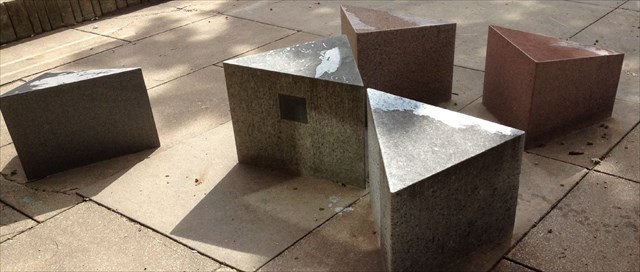
This earthcache illustrates some of the various examples of different granites found on campus. It is a short tour of the east bank campus that starts and ends near the East Bank light rail station, but the waypoints may be visited in any order. Parking is available on campus for a small charge. None of the rocks on this tour are in their natural habitat, but have all been assembled here because of their architectural, structural and aesthetic properties. In addition to the granites highlighted here, there are plenty of opportunities to study many other rock types; both architectural and the more mundane.
An igneous rocks forms from cooling magma and is typically composed of crystals. If the magma cooled beneath the Earth’s surface, the crystals are often large enough to be seen without magnification, forming a distinctive pattern of different colored minerals. On the other hand, if magma is ejected at the Earth’s surface as part of a volcanic eruption, any crystals formed will be much too small to see, so the resulting rocks appear to be uniform masses.
Igneous rocks can be classified by the crystal size, and also by the mineral composition of the rock. Some of the minerals present in the different rock types are:
· Felsic rock: highest content of silicon, with predominance of quartz, alkali feldspar and/or feldspathoids: these rocks (e.g., granite, rhyolite) are usually light colored, and have low density.
· Mafic rock: lesser content of silicon relative to felsic rocks, with predominance of mafic minerals pyroxenes, olivines and calcic plagioclase; these rocks (e.g., basalt, gabbro) are usually dark colored, and have a higher density than felsic rocks.
· Ultramafic rock: lowest content of silicon, with more than 90% of mafic minerals (e.g., dunite).
The following table is a simple subdivision of igneous rocks according to both their composition and mode of occurrence.
From this table we see that granite should have large crystals and contain the largest amounts of quartz and alkali feldspars. By definition, granite is an igneous rock with at least 20% quartz and up to 65% alkali feldspar by volume. It is the potassium feldspar that gives many granites a distinctive pink color.
Waypoint 1 (Posted coordinates) – Amundson Hall (west entrance). Next to Amundson Hall’s Church Street entrance are five short pedestals of igneous rock. Despite their varying hues, all five of these pedestals are varieties of granite, which illustrates why it pays to be cautious when using color to identify minerals and rocks. Even the darkest rock, which looks like gabbro, contains clear quartz crystals characteristic of granite. Try to find a few of these quartz crystals (doing so is easier in the reddish pedestals than the dark ones).
Waypoint 2 and 2a – Northrop Plaza benches and sidewalk borders throughout the mall area are made of a gray ‘salt and pepper’ colored rock quarried near Rockville, Minnesota. Distinctive for its large feldspar crystals, this rock is probably best displayed in the plaza’s low southern wall.

Waypoint 3 – Folwell Hall exterior (south entrance) ‘Xenolith’ is Greek for ‘foreign rock’ or ‘stranger rock’ and a number of xenoliths are encased in the granite walls and pillars of Folwell Hall’s south entrance. Once you start looking, it is easy to find a number of small irregular shapes distinct from the course matrix of the surrounding granite. These xenoliths formed as pieces of surrounding rock became caught up in magma that later cooled to form the granite. So Folwell’s exterior entrance not only hints at ancient plate collision and mountain building like other granites on the tour, but even gives you a glimpse of the country rock present before those processes began.
Waypoint 4 – Kenneth H. Keller Hall. Outside the entrance to the building is a tall column of granite which was designed, along with the alternating brickwork on the rest of the building, to represent an electronic device. The layers of this pillar are both polished and rough. As quarried, the granite is naturally rough, but it is made smooth and polished by grinding with hard abrasive particles. This process reveals the interior of the individual grains of the granite crystals, allowing us to see their size and shape rather well. For some of the minerals this morphology can be quite distinctive.
To log this earthcache please e-mail me the answers to the following questions. Do not put the answers in your log.
Waypoint 1 – What characteristic of their textures tells you that these rocks formed from magma that cooled miles below the Earth’s surface, rather than from lava erupted in a volcanic eruption at the Earth’s surface?
Waypoint 2 – What type of rock (igneous, sedimentary or metamorphic) do you think this rock is? What features of the rock support your choice? Do you think these rocks cooled faster or slower than those at waypoint 1 and describe why you came to your answer.
Waypoint 3 – Do most of the xenoliths you see here share a roughly similar appearance or do they appear to have come from a wide variety of different rock types? Describe one of the larger xenoliths you see.
Waypoint 4 – Estimate the size of the three main types of mineral grains visible in the polished sections. Do these measurements agree with what you see in the rough areas? What features of these surfaces might tell you how well each type of mineral will weather once exposed to the elements?
References
https://en.wikipedia.org/wiki/Igneous_rock
https://en.wikipedia.org/wiki/Granite
https://www.esci.umn.edu/sites/www.esci.umn.edu/files/Historic%20Campus%20Geology%20Exploration%20F14.pdf